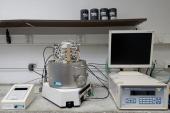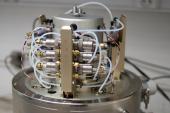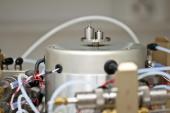 Name of Standard: National standard for gauge pressure,negative gauge pressure and absolute pressure in a gaseous medium
Name of Standard: National standard for gauge pressure,negative gauge pressure and absolute pressure in a gaseous medium
Code designation: ECM 170-1/01-017
Year of publication: 2001
Department: nr. 6013 CMI RI Brno
Guarantor: Ing. Zdeněk Krajíček
Number of CMS lines provided: 4
| Mode | Range | Uncertainty (k = 2) |
| Gauge pressure | 5 kPa – 10 MPa | 0,2 Pa + 1,0∙10-5∙p + 2,0∙10-13∙p2 |
| Negative gauge pressure | (5 – 100) kPa | 1,0 Pa + 1,2∙10-5∙p |
| Absolute pressure | 15 kPa – 7,6 MPa | 0,3 Pa + 1,1∙10-5∙p + 2,0∙10-13∙p2 |
| Absolute pressure | (7,6 – 10) MPa | 1,0 Pa + 1,2∙10-5∙p + 2,0∙10-13∙p2 |
The key position among the individual primary pressure standards is always occupied by the primary standard of gauge pressure, negative gauge pressure and absolute pressure in the gas medium, from which the other ranges are traditionally derived by various methods (vacuum ranges from absolute pressure using expansion methods, gauge pressure in the oil medium using a gas-oil separator, and pressure differentials from the combination).
The purchase of a commercially available DHI PG 7601 was chosen as a suitable solution to provide this range. The convenience of the chosen solution is also documented by the fact that other national laboratories (e.g. MIKES-Finland, NMi-Netherlands) have established their primary standards in the same way. Through long-term theoretical and experimental work in 1995-2000, the team led by Mgr. J. Tesař managed to prepare the standard scientifically and technically for the announcement as a national standard, which was successfully carried out in 2001.
The basis of the primary group standard consists of three geometrically evaluated pressure gauges with a nominal effective area Aef = 10.0 cm2. Using hydrostatic comparison with extrapolation, piston-cylinders with nominal effective area Aef = 2.0 cm2 and Aef = 0.5 cm2 are sequentially linked. These can be changed in the base of the DHI PG 7601 piston pressure gauge with internal sensors for pressure gauge temperature, pressure gauge position, ambient temperature, ambient humidity, barometric pressure, vacuum reference and a set of weights. The absolute pressure is realized by means of an evacuatable bell jar and vacuum reference; the negative gauge mode is realized by means of an inverted connection with the aforementioned bell. Two of these bases are available.
In 2005, this standard was upgraded, mainly by retrofitting it with the AMH automatic weight change system, which led to a reduction of uncertainties, a reduction in weight wear and a higher efficiency of the calibrations performed by this instrument.
The absolute pressure generated by the national standard is calculated according to the definition equation:
where stands for:
λ...........…. | deformation coefficient of the piston-cylinder, |
α.......…..... | the angle between the direction of acceleration due to gravity and the perpendicular to the piston |
m.....…...... | mass, |
g......…...... | acceleration due to gravity, |
αp......…...... | coefficient of thermal expansion of the piston, |
αc......…..... | coefficient of thermal expansion of the cylinder, |
pvac…….… | residual vacuum pressure, |
T0.......…..... | reference temperature, |
Aef (0,T0).... | the size of the effective area of the piston-cylinder at zero pressure and reference temperature. |
When gauge pressure or negative gauge pressure is generated, the definitional equation is modified to::
where ρa is the density of the air and ρm is density of weights.




